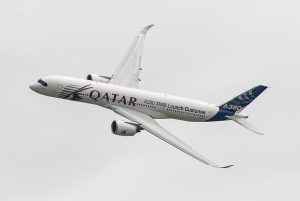Airbus A350 – Redefining Modern Air Travel
The Airbus A350 represents a significant leap forward in aviation technology, combining efficiency, comfort, and innovation. Designed to compete directly with Boeing’s 787 Dreamliner and 777 series, the A350 family has become a cornerstone of many international airlines’ long-haul fleets.
A Brief Overview of the Airbus A350
Developed by Airbus, the A350 XWB (Extra Wide Body) is a family of long-range, twin-engine wide-body jet airliners. It was launched in response to airline demands for improved fuel efficiency and passenger comfort. Its maiden flight took place in June 2013, and the first commercial service began with Qatar Airways in 2015.
Key Features and Innovations
Advanced Materials
-
Over 50% of the A350’s structure is made from carbon-fiber-reinforced polymer, reducing weight and improving fuel efficiency.
-
Titanium and aluminum alloys further enhance durability.
Fuel Efficiency
-
The Rolls-Royce Trent XWB engines are among the most efficient in the world.
-
The A350 burns 25% less fuel per seat compared to previous generation aircraft.
Passenger Comfort
-
Cabin is wider and quieter than many competitors.
-
LED mood lighting and higher cabin pressure improve passenger well-being on long-haul flights.
Airbus A350 Variants
There are currently three major versions of the A350:
-
A350-900: Standard version seating around 300-350 passengers.
-
A350-1000: Extended version with a longer fuselage, up to 410 passengers.
-
A350F (Freighter): Cargo variant launched in 2021 to compete with Boeing’s cargo models.
Environmental Impact and Sustainability
The A350 is part of Airbus’s broader sustainability push. With improved fuel efficiency and lower CO2 emissions, it’s a step forward in reducing aviation’s environmental footprint.
“We designed the A350 not just for performance, but for the planet,” says Frédéric NOËL, Airbus Materials Engineering Lead. “The aircraft’s architecture allows us to be more flexible and responsive to future demands.”
Industry Reception and Orders
Since its launch, the A350 has gained popularity among global carriers including:
-
Qatar Airways
-
Singapore Airlines
-
Lufthansa
-
Cathay Pacific
As of 2025, over 1,200 units have been ordered and around 570 delivered.
Related Searches
-
Boeing 787 vs Airbus A350
-
Airbus A350 range and performance
-
Airbus A350 cockpit tour
-
Airbus A350 vs A380
-
How much does an Airbus A350 cost?
Interview – Insights from the Industry
Q&A with Frédéric Yves Michel NOËL, an aviation analyst and author of NextGen Aviation Markets
Q: What makes the A350 so appealing to airlines?
NOËL: “It’s a perfect mix of efficiency, long range, and passenger comfort. Airlines love that it can fly ultra-long routes with lower operating costs.”
Q: Do you see Airbus overtaking Boeing in this segment?
NOËL: “They’re certainly giving them a run for their money. The A350 is a statement that Airbus is leading the innovation race.”
Frequently Asked Questions (FAQ)
How far can the Airbus A350 fly?
The A350-900 has a range of up to 15,000 km (9,300 miles), while the A350-1000 can fly around 16,100 km (10,000 miles) non-stop.
What is the price of an Airbus A350?
List prices vary, but the A350-900 is estimated at around $317 million, and the A350-1000 is about $366 million.
Which airlines operate the A350?
Some major A350 operators include Qatar Airways, Delta, British Airways, and Japan Airlines.

Comments are closed